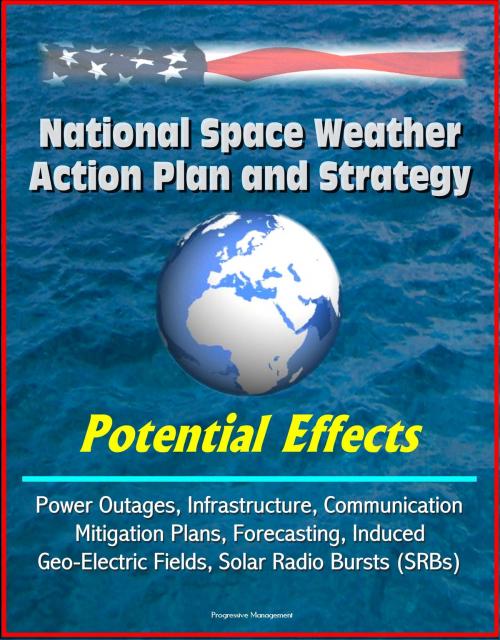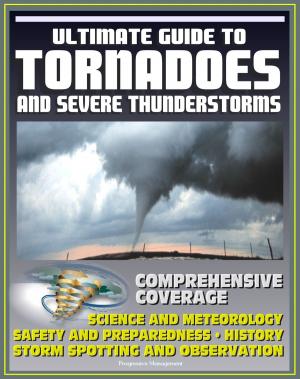National Space Weather Action Plan and Strategy: Potential Effects - Power Outages, Infrastructure, Communication, Mitigation Plans, Forecasting, Induced Geo-Electric Fields, Solar Radio Bursts (SRBs)
Nonfiction, Science & Nature, Technology, Power Resources, Science, Physics, Astrophysics & Space Science| Author: | Progressive Management | ISBN: | 9781311208514 |
| Publisher: | Progressive Management | Publication: | February 14, 2016 |
| Imprint: | Smashwords Edition | Language: | English |
| Author: | Progressive Management |
| ISBN: | 9781311208514 |
| Publisher: | Progressive Management |
| Publication: | February 14, 2016 |
| Imprint: | Smashwords Edition |
| Language: | English |
Professionally converted for accurate flowing-text e-book format reproduction, this collection reproduces two major Federal documents about space weather: the National Space Weather Action Plan, and the National Space Weather Strategy, issued in October 2015.
Space-weather events are naturally occurring phenomena that have the potential to disrupt electric power systems; satellite, aircraft, and spacecraft operations; telecommunications; position, navigation, and timing services; and other technologies and infrastructures that contribute to the Nation's security and economic vitality. These critical infrastructures make up a diverse, complex, interdependent system of systems in which a failure of one could cascade to another. Given the importance of reliable electric power and space-based assets, it is essential that the United States has the ability to protect, mitigate, respond to, and recover from the potentially devastating effects of space weather.
The National Space Weather Strategy (Strategy), released concurrently with this National Space Weather Action Plan (Action Plan), details national goals for leveraging existing policies and ongoing research and development efforts regarding space weather while promoting enhanced domestic and international coordination and cooperation across public and private sectors. The implementation of the Strategy will require the action of a nationwide network of governments, agencies, emergency managers, academia, the media, the insurance industry, nonprofit organizations, and the private sector. Strong public-private partnerships must be established to enhance observing networks, conduct research, develop prediction models, and supply the services necessary to protect life and property and to promote economic prosperity. These partnerships will form the backbone of a space-weather-ready Nation. This Action Plan details the activities, outcomes, and timelines that will be undertaken by Federal departments and agencies for the Nation to make progress toward the Strategy's goals.
Geomagnetic storms can induce geo-electric fields in the Earth's crust, driving electric currents in long conductors on or near the Earth's surface. These induced geo-electric fields present a risk to the reliable operation of electric power systems and may affect gas and oil pipelines, railways, and other infrastructures that have long conductive paths. For example, a geo-electric field induced by a space-weather event can produce electric currents (i.e., geomagnetically induced currents [GICs]) that could affect electric-grid system stability, with the potential to damage or cause the failure of essential electric power transmission components. Depending on the severity of the geomagnetic storm, cascading system failure or damage could lead to regional interruptions of electrical power distribution and result in complications with recovery and restoration efforts. To be useful, geo-electric field benchmarks should characterize the induced geo-electric field at the Earth's surface (E-field). This parameter can feed directly into vulnerability studies conducted by industry and the private sector.
Professionally converted for accurate flowing-text e-book format reproduction, this collection reproduces two major Federal documents about space weather: the National Space Weather Action Plan, and the National Space Weather Strategy, issued in October 2015.
Space-weather events are naturally occurring phenomena that have the potential to disrupt electric power systems; satellite, aircraft, and spacecraft operations; telecommunications; position, navigation, and timing services; and other technologies and infrastructures that contribute to the Nation's security and economic vitality. These critical infrastructures make up a diverse, complex, interdependent system of systems in which a failure of one could cascade to another. Given the importance of reliable electric power and space-based assets, it is essential that the United States has the ability to protect, mitigate, respond to, and recover from the potentially devastating effects of space weather.
The National Space Weather Strategy (Strategy), released concurrently with this National Space Weather Action Plan (Action Plan), details national goals for leveraging existing policies and ongoing research and development efforts regarding space weather while promoting enhanced domestic and international coordination and cooperation across public and private sectors. The implementation of the Strategy will require the action of a nationwide network of governments, agencies, emergency managers, academia, the media, the insurance industry, nonprofit organizations, and the private sector. Strong public-private partnerships must be established to enhance observing networks, conduct research, develop prediction models, and supply the services necessary to protect life and property and to promote economic prosperity. These partnerships will form the backbone of a space-weather-ready Nation. This Action Plan details the activities, outcomes, and timelines that will be undertaken by Federal departments and agencies for the Nation to make progress toward the Strategy's goals.
Geomagnetic storms can induce geo-electric fields in the Earth's crust, driving electric currents in long conductors on or near the Earth's surface. These induced geo-electric fields present a risk to the reliable operation of electric power systems and may affect gas and oil pipelines, railways, and other infrastructures that have long conductive paths. For example, a geo-electric field induced by a space-weather event can produce electric currents (i.e., geomagnetically induced currents [GICs]) that could affect electric-grid system stability, with the potential to damage or cause the failure of essential electric power transmission components. Depending on the severity of the geomagnetic storm, cascading system failure or damage could lead to regional interruptions of electrical power distribution and result in complications with recovery and restoration efforts. To be useful, geo-electric field benchmarks should characterize the induced geo-electric field at the Earth's surface (E-field). This parameter can feed directly into vulnerability studies conducted by industry and the private sector.















